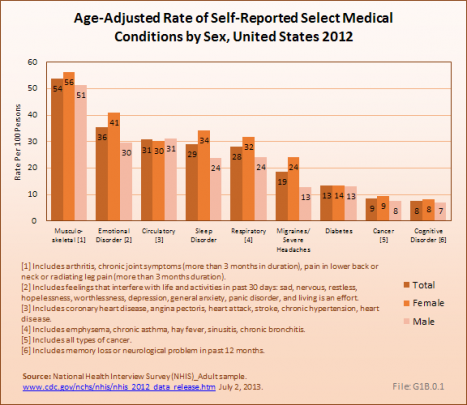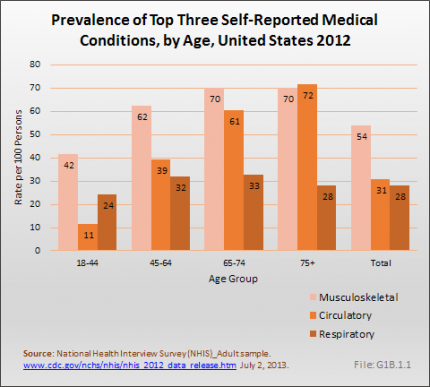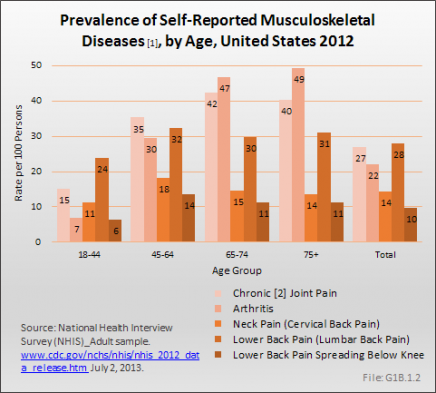

In the National Health Interview Survey (NHIS) in 2012, musculoskeletal medical conditions were reported by 126.6 million adults in the United States, representing more than one in two persons age 18 and over of the estimated 2012 population. The rate of chronic musculoskeletal conditions found in the adult population is 76% greater than that of chronic circulatory conditions, which include coronary and heart conditions, and nearly twice that of all chronic respiratory conditions. On an age-adjusted basis, musculoskeletal conditions are reported by 54 persons per every 100 in the population. This compares to a rate of 31 and 28 persons per every 100 in the population for circulatory and respiratory conditions, respectively. The NHIS annual survey of self-reported health conditions is used throughout this chapter to highlight chronic health conditions of the US population. (Reference Table 1.2.1 PDF [1] CSV [2])
On an age-adjusted basis, females report a higher rate of occurrence than males for most major medical conditions. Among females, 56 out of every 100 females in the population report musculoskeletal conditions; among males the rate is only slightly lower at 51 per 100, a slight increase in recent years. (Reference Table 1.2.1 PDF [1] CSV [2])
Musculoskeletal conditions are found among all age groups, with the proportion of persons reporting these conditions increasing with age. Musculoskeletal conditions are reported by nearly three of four (70%) persons age 65 years and over. This compares to the 61% of persons age 65 to 74 years, and only slightly less than the 72% of those aged 75 years and older, reporting circulatory conditions, the majority of whom report chronic hypertension. (Reference Table 1.2.2 PDF [3] CSV [4] and Table 1.3.2 PDF [5] CSV [6])
Musculoskeletal conditions were reported at a higher rate among whites and persons of mixed or other races, with 56 and 57 persons, respectively, in every 100 person in the population reporting a musculoskeletal condition. Among persons of the black/African American race, 48 in 100 reported a musculoskeletal condition. Persons of Asian descent reported the lowest level of musculoskeletal conditions, at a rate of 40 persons in every 100 persons in the population. (Reference Table 1.2.3 PDF [7] CSV [8]) The rate of musculoskeletal conditions among black/African Americans and those of Asian descent increased by several percentage points from those reported in 2008.1


Chronic joint pain increases with age, but peaks in the 65- to 74-year age group. Among the 63.1 million persons reporting chronic joint pain in 2012, knee pain is the most frequently cited, with 40 million people reporting knee pain. Chronic knee pain is reported by all ages older than 18![Proportion of Population [1] Age 18 and Older Reporting Joint Pain [2], United States 2012 Proportion of Population [1] Age 18 and Older Reporting Joint Pain [2], United States 2012](https://bmus.latticegroup.com/docs/resize/G1B.2-239x416.png) years, with more than one in four aged 65 and older reporting knee pain. Shoulder pain, reported by 18.7 million of those age 18 and older, is the second most common joint for chronic pain, with rates fairly equal for those age 45 and older. Hip pain was reported by 15.3 million persons age 18 and older.
years, with more than one in four aged 65 and older reporting knee pain. Shoulder pain, reported by 18.7 million of those age 18 and older, is the second most common joint for chronic pain, with rates fairly equal for those age 45 and older. Hip pain was reported by 15.3 million persons age 18 and older.
While multiple joints can be the source of chronic joint pain, overall, one in four people over the age of 18 report chronic joint pain. The ratio jumps to more than two in five after the age of 65 years. However, even among younger adults age 18 to 44, about one in six report chronic joint pain. (Reference Table 1.4.2 PDF [13] CSV [14])
Females report higher rates of chronic joint pain than do males, with the exception of shoulder pain. Race is not a variable in the rate of chronic joint pain, with the exception of those of Asian race, who report lower joint pain rates than other racial groups. (Reference Table 1.4.1 PDF [15] CSV [16] and Table 1.4.3 PDF [17] CSV [18])
Links:
[1] https://bmus.latticegroup.com/docs/T1.2.1.pdf
[2] https://bmus.latticegroup.com/docs/T1.2.1.csv
[3] https://bmus.latticegroup.com/docs/T1.2.2.pdf
[4] https://bmus.latticegroup.com/docs/T1.2.2.csv
[5] https://bmus.latticegroup.com/docs/T1.3.2.pdf
[6] https://bmus.latticegroup.com/docs/T1.3.2.csv
[7] https://bmus.latticegroup.com/docs/T1.2.3.pdf
[8] https://bmus.latticegroup.com/docs/T1.2.3.csv
[9] https://bmus.latticegroup.com/docs/T1.3.1.pdf
[10] https://bmus.latticegroup.com/docs/T1.3.1.csv
[11] https://bmus.latticegroup.com/docs/T1.3.3.pdf
[12] https://bmus.latticegroup.com/docs/T1.3.3.csv
[13] https://bmus.latticegroup.com/docs/T1.4.2.pdf
[14] https://bmus.latticegroup.com/docs/T1.4.2.csv
[15] https://bmus.latticegroup.com/docs/T1.4.1.pdf
[16] https://bmus.latticegroup.com/docs/T1.4.1.csv
[17] https://bmus.latticegroup.com/docs/T1.4.3.pdf
[18] https://bmus.latticegroup.com/docs/T1.4.3.csv